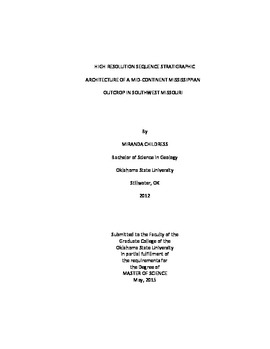| dc.contributor.advisor | Grammer, George M. | |
| dc.contributor.author | Childress, Miranda Nichole | |
| dc.date.accessioned | 2016-04-15T21:49:12Z | |
| dc.date.available | 2016-04-15T21:49:12Z | |
| dc.date.issued | 2015-05-01 | |
| dc.identifier.uri | https://hdl.handle.net/11244/33395 | |
| dc.description.abstract | The Mid-Continent Mississippian Limestone represents a geologically complex system containing different depositional environments and dynamic diagenetic and tectonic histories. This thick (up to 500 ft) carbonate unit was deposited in an east-west oriented belt with a northern and southern boundary within 5�-30� of the paleo-equator. Its subsurface equivalent is an unconventional oil and gas play in Oklahoma and Kansas with well-exposed outcrops in Missouri and Arkansas. The Mississippian-age strata in this area has been interpreted by some to be deposited in a shelf margin environment based on over-simplified paleo-depositional maps. In this study, detailed outcrop analysis has revealed the depositional environment is more consistent with a distally steepened ramp and that complex and dynamic facies mosaics exist across the distally steepened ramp due to lateral migration of facies, complicating the lithology-based nomenclature used throughout the Mid-Continent.Understanding how primary depositional facies fit into a sequence stratigraphic framework will increase predictability of reservoir facies. The high resolution sequence stratigraphic architecture study at the Jane outcrop provides a basin specific analog for identification of reservoir facies in the subsurface. This study includes analyses of facies vertically and horizontally to identify geometries and vertical stacking patterns on the third-, fourth-, and fifth-order scales. Using an integrated sequence stratigraphic approach combining Gigapan imaging, thin section analysis, scanning electron microscopy, and spectral gamma ray logs identified a repeated shallowing-upward succession of facies ranging from bryozoan-crinoidal wackestones to bryozoan crinoidal grainstones, likely at the 4th order scale.Integrating this sequence stratigraphic approach with an understanding of the probable complexity of facies mosaics from modern analogs has led to a modified time-series of paleo-depositional maps that better illustrate the complex facies mosaics associated with Milankovitch-scale sea level change. The high resolution sequence stratigraphic architecture developed at the Jane outcrop provides a datum for a more accurate interpretation of how Mississippian lithofacies fit into the sequence stratigraphic framework. A high resolution sequence stratigraphic architecture study that incorporates primary facies, depositional environments, and gamma ray response within a larger scale 2-D geometry for an outcrop can be used as a basin specific analog to identify reservoir facies in the subsurface. | |
| dc.format | application/pdf | |
| dc.language | en_US | |
| dc.publisher | Oklahoma State University | |
| dc.rights | Copyright is held by the author who has granted the Oklahoma State University Library the non-exclusive right to share this material in its institutional repository. Contact Digital Library Services at lib-dls@okstate.edu or 405-744-9161 for the permission policy on the use, reproduction or distribution of this material. | |
| dc.title | High Resolution Sequence Stratigraphic Architecture of a Mid-continent Mississippian Outcrop in Southwest Missouri | |
| dc.type | text | |
| dc.contributor.committeeMember | Puckette, Jim | |
| dc.contributor.committeeMember | Boardman, Darwin R., II | |
| dc.contributor.committeeMember | Gregg, Jay | |
| osu.filename | Childress_okstate_0664M_13843.pdf | |
| osu.accesstype | Open Access | |
| dc.description.department | Geology | |
| dc.type.genre | Thesis | |
